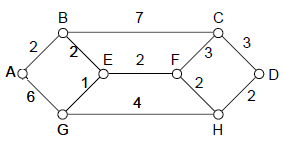Question

a.
10
b.
11
c.
12
d.
14
Posted under Networking
Engage with the Community - Add Your Comment
Confused About the Answer? Ask for Details Here.
Know the Explanation? Add it Here.
Q. Find the distance from source A to destination D using Dijkstra algorithm.
Similar Questions
Discover Related MCQs
Q. A pure ALOHA network transmits 200-bit frames on a shared channel of 200 kbps. What is the requirement to make this frame collision-free?
View solution
Q. Fiber Distributed Data Interface (FDDI) and Copper Distributed Data Interface (CDDI) uses
View solution
Q. In Frequency Division Multiple Access, the data link layer in each station tells its physical layer to make
View solution
Q. When a station needs to make a reservation before sending data then it is called the
View solution
Q. If the station has been authorized by other stations then a station can
View solution
Q. FDMA, TDMA and CDMA are
View solution
Q. The collision may result in
View solution
Q. In Frequency Division Multiple Access, the bandwidth of each channel is shifted by the
View solution
Q. The type which improves the efficiency of pure ALOHA is
View solution
Q. In token passing method, the station can send data when it receives the
View solution
Q. During collisions in the wired network, the detecting energy is almost
View solution
Q. The number of sequences in a Walsh table i.e. N=
View solution
Q. The p-persistent method uses its back off procedure if the line is
View solution
Q. Multiple-access Protocol is divided into
View solution
Q. In Carrier Sense Multiple Access/Collision Detection (CSMA/CD), we do not send the entire frame and then look for a
View solution
Q. A pure ALOHA can transmit the 200-bit frames on a shared channel of
View solution
Q. The p-persistent method is used if the time slots with a slot duration equal to or greater than the maximum of
View solution
Q. A collision in a wireless network may add additional energy from 5 to
View solution
Q. Walsh table is a two-dimensional table in which the number of rows and columns are
View solution
Q. In Code Division Multiple Access, the orthogonal sequence is unique for each
View solution
Suggested Topics
Are you eager to expand your knowledge beyond Networking? We've curated a selection of related categories that you might find intriguing.
Click on the categories below to discover a wealth of MCQs and enrich your understanding of Computer Science. Happy exploring!








